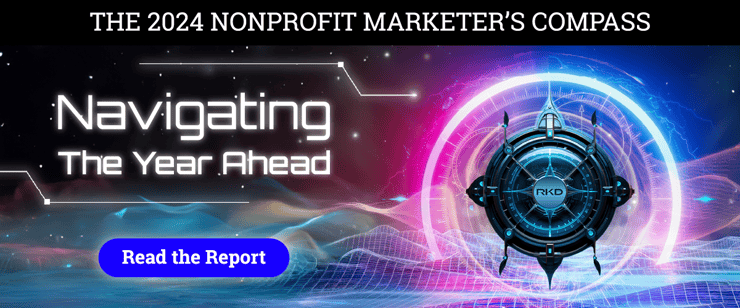Congratulations on making it through the leap day, celebrating Facebook's 20th anniversary and enduring the spring forward time change (a bit of a yawn, we know)!
 Here at RKD, we've been bustling with activity, unveiling The 2024 Nonprofit Marketer’s Compass and debuting a new podcast, Group: Chat, which features insightful interviews with our incredibly talented client partners. And perhaps you've already noticed the sleek new layout of our monthly Thinkers newsletter.
Here at RKD, we've been bustling with activity, unveiling The 2024 Nonprofit Marketer’s Compass and debuting a new podcast, Group: Chat, which features insightful interviews with our incredibly talented client partners. And perhaps you've already noticed the sleek new layout of our monthly Thinkers newsletter.
Below, you’ll find some of the captivating highlights from recent fundraising and philanthropy articles that have caught my attention, along with some essential preparations for the upcoming quarter.
But first, a few housekeeping and data hygiene reminders that are important to focus on this time of year:
Hygiene tip #1: Now is a great time to review/prep your donation forms. You have time to test the forms and pages by starting now. Are you offering any information on planned giving at the bottom of your form (donor advised funds, etc.)? While you’re working on it, remember those company matching gifts. Also, are you offering the donor an option to pay for the credit card processing fee?
Hygiene tip #2: Review the Do Not Mail donors and those donors who have flags for once a year or spring only – you know which ones I’m talking about. If those donors didn’t give when they claimed they would, it’s time to release the flag and begin asking them to donate again. This might include lapsed monthly sustainers. Often these flags become a catch-all for donor complaints about receiving too much mail – and they can grow significantly. Unless something is done to reevaluate these names, we’ve pigeonholed these donors and relegated them to “Newsletter Only” or “Spring Only” purgatory for eternity.
Hope you can take a moment to relax with your favorite beverage and indulge in a quick five-minute catch-up! You may have already stumbled upon these articles in the past month; if not, here's a brief update for you.
1. The 2024 Nonprofit Marketer's Compass: Your guide to the road ahead
 We’ve stopped talking about #quitbadfundraising and provided a guide to help nonprofit organizations face the challenges ahead. The Compass dives deep into four major beacons that will propel our industry forward into a new era that meets donors’ elevated expectations:
We’ve stopped talking about #quitbadfundraising and provided a guide to help nonprofit organizations face the challenges ahead. The Compass dives deep into four major beacons that will propel our industry forward into a new era that meets donors’ elevated expectations:
- Connect the Dots
- Think Dimensionally
- Be You
- Plan with Care
Each one is broken down in great detail in the e-book, and they align with the projects and efforts we’re making internally to meet the challenges of our sector. You can read more from Chris Pritcher on his blog post I’m done quitting. Let’s chart a new course forward.
2. My Essay on Why I Stopped Donating Went Viral. Here's What I've Learned Since
 Theodore Wagenaar returns to discuss what he has learned since his first opinion essay went viral about why he stopped donating to charities. I’m certain we are all glad he learned more about how nonprofits work and of his reminder that we all need to remember it’s a two-way street. If you didn’t catch our RKD podcast last summer with him, it’s a great primer to this follow-up opinion essay.
Theodore Wagenaar returns to discuss what he has learned since his first opinion essay went viral about why he stopped donating to charities. I’m certain we are all glad he learned more about how nonprofits work and of his reminder that we all need to remember it’s a two-way street. If you didn’t catch our RKD podcast last summer with him, it’s a great primer to this follow-up opinion essay.
3. Dogs, Octopuses and Cash: Two TikTok Fundraising Success Stories
 Nonprofit organizations have turned to the popular video-sharing platform to connect with fans and raise money. Some groups that work with animals have found success using TikTok to connect with their biggest fans and raise money to support their missions. One of the key potential benefits for nonprofits: TikTok can be a place to connect with young supporters. TikTok is known for short videos that reel viewers in, often with content that is humorous, lighthearted, informational or trending.
Nonprofit organizations have turned to the popular video-sharing platform to connect with fans and raise money. Some groups that work with animals have found success using TikTok to connect with their biggest fans and raise money to support their missions. One of the key potential benefits for nonprofits: TikTok can be a place to connect with young supporters. TikTok is known for short videos that reel viewers in, often with content that is humorous, lighthearted, informational or trending.
- Be real: On TikTok, people want to see things they could’ve created themselves.
- Include a donate button.
- Teamwork makes the dream work.
- Audiences may be far-flung. Be mindful of which type of audience you’re reaching on the platform.
4. Thanks everyone for comments on the draft, here it is revised with all your edits.
 Ben Phillps posted this tweet and meme on September 17, 2023. Plenty have had a heyday, jumping on the bandwagon with their experiences and thoughts. Afterall, everyone in fundraising has lived this nonsense.
Ben Phillps posted this tweet and meme on September 17, 2023. Plenty have had a heyday, jumping on the bandwagon with their experiences and thoughts. Afterall, everyone in fundraising has lived this nonsense.
- “I just don’t like this photo.”
- “My best friend’s mother’s neighbor just doesn’t understand it.”
- “Wrong angle on that chicken, please reshoot the photo.”
- “That caption just doesn’t express it correctly.”
- “Add your own feedback.”
Would you let someone perform surgery on you if they didn’t go to medical school?
5. Will the Election and Economy Hurt Philanthropy in 2024?
![]() Presidential elections have a negligible effect on overall charitable giving trends. Charitable giving increased in eight of the past nine presidential election years, per Giving USA data. The exception was in 2008 during the financial crisis. Donors in the majority of election years appear to give to both charity and campaigns, and there is little empirical evidence to support a giving effect of an election year. Nonprofits in 2024 should reaffirm their organizational mission, purpose and values.
Presidential elections have a negligible effect on overall charitable giving trends. Charitable giving increased in eight of the past nine presidential election years, per Giving USA data. The exception was in 2008 during the financial crisis. Donors in the majority of election years appear to give to both charity and campaigns, and there is little empirical evidence to support a giving effect of an election year. Nonprofits in 2024 should reaffirm their organizational mission, purpose and values.
6. Giving with Purpose: How affluent households contributed in 2022
 The 2023 Bank of America Study of Philanthropy: Charitable Giving by Affluent Households, conducted in partnership with Indiana University, has been released.
The 2023 Bank of America Study of Philanthropy: Charitable Giving by Affluent Households, conducted in partnership with Indiana University, has been released.
Affluent households make up a large proportion of all charitable giving in the United States. Understanding the priorities and motivations that underlie and shape affluent philanthropic engagement is key to understanding philanthropy overall.
Key findings:
- The affluent continue to lead in charitable giving.
- Volunteering is on the rebound among affluent Americans.
- Affluent Americans leverage a robust toolkit of strategies to achieve philanthropic goals.
- Affluent women are a force for change in the philanthropic sector.
- Religious organizations continue to receive the largest share of giving dollars by affluent households.
- The future of philanthropy relies on engaging the next generation of affluent Americans.
7. The DAF Research Collaborative Releases Independent National Study on Donor-Advised Funds
![]() The 2024 National Study on Donor Advised Funds is the largest independent study on donor advised funds to date, encompassing nine years of data and details on more than 50,000 accounts.
The 2024 National Study on Donor Advised Funds is the largest independent study on donor advised funds to date, encompassing nine years of data and details on more than 50,000 accounts.
Diving deeper into key findings:
- Nearly half of all DAFs (49%) had total assets at the end of 2021 of less than $50,000. Only 7% of DAFs had balances of $1 million or more. Only 1% had a balance over $10 million.
- DAFs are a relatively young philanthropic vehicle, with increased use in recent years (81% of DAF accounts in the study were opened after 2010).
- Most DAF accounts (97%) were advised by individuals or families. Organizations advised only 3% of DAFs in the study.
- Members of the Baby Boomer generation represented nearly half (49%) of all advisors.
- Almost all DAFs (92%) have a succession plan in place that establishes what organization or advisors receive control of the funds after the original donors are no longer living. Approximately 30% of DAFs designate the sponsor or another nonprofit organization to receive the remaining funds.
- Approximately 61% of all DAFs had multiple contributions into the DAF during the study period. One in nine had contributions every year.
- DAFs are a mid-range philanthropic vehicle option for donors. DAFs commonly received contributions between $10,000 and $49,999. About 40% of contributions were in this range.
- In the most recent three-year period, 78% of accounts made at least one grant. In an average year, nearly two-thirds of accounts (63%) made an outbound grant, while over one-third (37%) did not.
- Grantmaking from DAFs is spread relatively evenly throughout the year—only 32% of grant funding occurs in the fourth quarter. In contrast, the fourth quarter of the year accounts for 57% of all funds contributed into DAFs.
- Since DAF contributions and grants can fluctuate yearly, this study presents a three-year average to provide a more accurate depiction of each DAF account’s activity. The median payout rate for all accounts is 9%. The median for all accounts that make grants (removing inactive accounts) is 15%. The mean (average) payout rate for all DAF accounts is 18%.
- Just over half of all DAFs (54%) granted out more than half of their original contribution within three years.
- Approximately 22% of DAFs were inactive or had a zero-payout rate for the three most recent years included in the study (2020-2022). When looking more closely at inactive DAFs, they were both smaller and newer (more recently established) than active DAFs. Almost half (45%) of inactive DAFs were opened in 2020 or later.
8. Economic Headlines
 The University of Michigan released its sentiment survey data at the end of February, which followed the consumer confidence data that showed the first decline since November. Cracks in the consumer's very resilient shell began to emerge with muted retail sales, but by and large things are still pretty good.
The University of Michigan released its sentiment survey data at the end of February, which followed the consumer confidence data that showed the first decline since November. Cracks in the consumer's very resilient shell began to emerge with muted retail sales, but by and large things are still pretty good.
 Investors will face the final major test before the Federal Reserve's March 20 meeting when the February Consumer Price Index (CPI) report will offer an updated look at inflation. Retail sales and consumer sentiment reports will also be featured on the economic calendar.
Investors will face the final major test before the Federal Reserve's March 20 meeting when the February Consumer Price Index (CPI) report will offer an updated look at inflation. Retail sales and consumer sentiment reports will also be featured on the economic calendar.
During earnings calls spanning from Dec. 15 to March 7, 47 S&P 500 companies cited the term "recession," according to research from FactSet. It was the lowest number of companies mentioning the phrase in two years and was below both the five- and 10-year averages of mentions.
The U.S. Senate, by a vote of 75-22, passed a $460B package of six spending bills to fund a group of federal agencies through the end of the fiscal year on Sept. 30, avoiding a partial government shutdown hours before a midnight deadline.
The U.S. economy added 275,000 jobs in February, exceeding expectations. The latest figure marks the third straight month of job gains above 200,000 and is the 39th consecutive month of gains overall.
9. Visit the RKD Resources Website Page for some great posts, podcasts and webinars
- I’m done quitting. Let’s chart a new course forward
- Beyond dashboards: Tailoring measurement to nonprofits' unique needs
- How social media can boost your nonprofit's organic search traffic
- Cracking the code: The science behind optimal touchpoints for unbeatable impact
- Gimme that BIMI: A quick way to stand out in email inboxes
- Does your food bank have a learning agenda?
Group: Thinkers Monthly LinkedIn Update:
- Mardi Gras magic: An exciting launch for the 2024 Nonprofit Marketer's Compass
- Get ready to enter the next phase of the economy, AI and fundraising
- From renovation rumbles to charity cheer: Nonprofit news to end the year!
- Someone stole my mail and put me in a direct response stranglehold
- Trick or treat? What to make of the economy with year-end season upon us
- Chat: Meet Jane McGrath from American Bible Society
- Thinkers: Showing up authentically and creating space with Sterrin Bird
- Chat: Meet Julie Puzzo at American Kidney Fund
- Thinkers: Promoting equity and inclusion through nonprofit data with Meena Das
- Thinkers: The evolution of audience-centric fundraising strategy with Stephanie Russell
Webinars and Past Webinar Recordings:
- Last-minute tips for Giving Tuesday Success with Evan Arcoria
- Nonprofits: Get more out of GA4 with Jenn Thompson & Kord Hickson
- Rebuild trust and reach new audiences at the same time w/Nicole Daily
- Transform your newsletters to be donor-centric with Lisa Rossi
- Craft captivating videos that engage your donors with Chris Weiland
- How to build stories around your content with Billy Vaudry






Leave a comment: